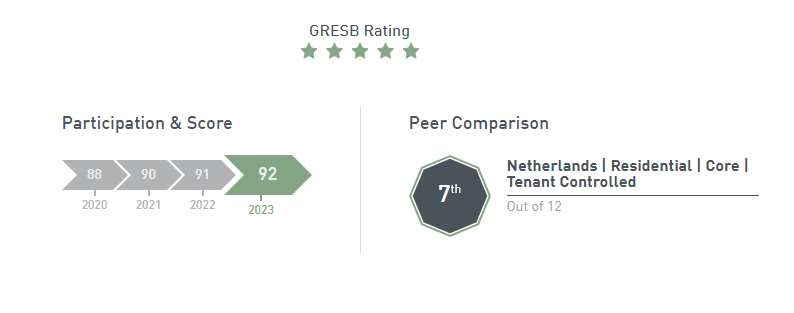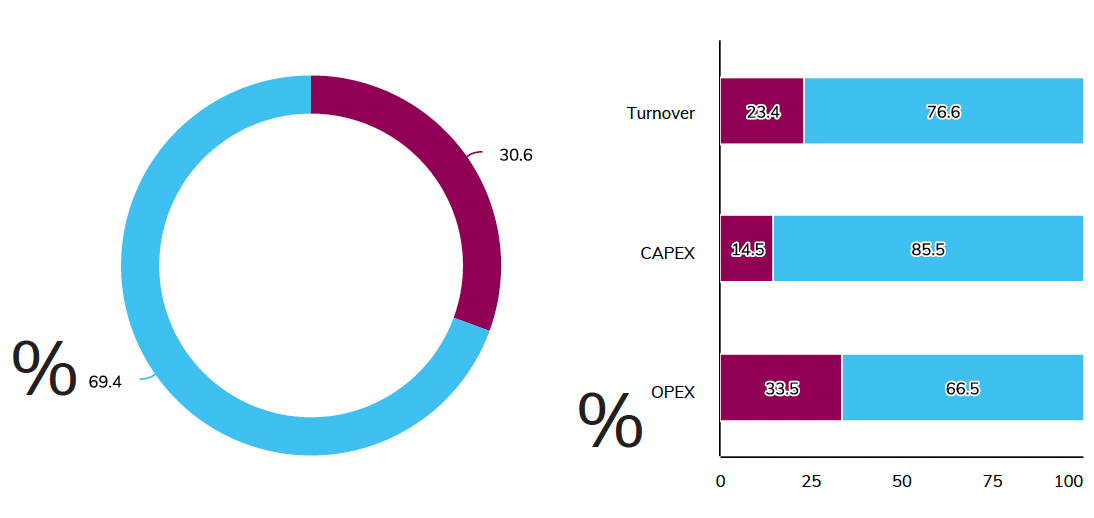Performance on sustainability
Highlights performance on sustainability
KPI | 2023 | 2022 | |
1. Building a future-proof and sustainable portfolio | |||
Above-average sustainable fund | Improvement annual GRESB score | 92 | 91 |
GRESB (5-)star rating | 5 | 5 | |
Above-average sustainable buildings | Building certificate GPR Gebouw score | 6.64 | 6.53 |
2. Reducing environmental impact | |||
Combatting climate change: source of energy | Gas-free assets (% m2) | 48% | 44% |
Scope 2 CO2 emissions in kg CO2 m2 (electricity purchased by the Fund) | 100% | 100% | |
Combatting climate change: energy efficiency of buildings | Average energy intensity* | 134 kWh/m2 | 139 kWh/m2 |
3. Liveable, affordable, attainable and inclusive places where people want to reside - now and in the future | |||
Affordability: mid-rental segment acquisitions | Newly signed acquisitions in the mid-rental segment | 0% | 80% |
Product accountability | Tenant satisfaction score | 7.2 | 7.3 |
4. Contributing to healthy, safe and responsible operations | |||
Considerate constructors scheme (construction sites) | Construction sites with considerate constructors scheme (% €) | 100% | 86.50% |
*Concerns BENG2 score (theoretical primary building-related energy consumption) |
Promoted ecological and social characteristics
The Fund promotes ecological and social characteristics and is therefore classified as an Article 8 product according to the SFDR. In 2023, the Fund introduced its ESG Framework, which explicitly defines all ESG-related elements for the Fund. The Fund has defined four ESG objectives, which reflect the environmental and social characteristics that the Fund promotes. The ESG objectives are at the heart of the Fund’s strategy and support four United Nations Sustainable Development Goals (SDGs).
-
Building a future-proof and sustainable portfolio;
-
Reducing environmental impact;
-
Liveable, affordable, attainable & inclusive places where people want to reside – now and in the future;
-
Contributing to healthy, safe and responsible operations.

1. Building a future-proof and sustainable portfolio
Above-average sustainable fund
For 2023, the Fund aimed to continue to improve its sustainability performance, improve its GRESB score and retain its 5-star rating. The Fund succeeded in these efforts. It increased its score by one point to 92 (from 91 in 2022) and retained its GRESB 5-star rating, which puts the Fund among the top 20% worldwide. The 2023 outcome placed the Fund seventh (out of 12) in a peer comparison.
The higher GRESB score was primarily the result of improvements in performance indicators. To retain its GRESB 5-star rating, the Fund will continue to increase its focus on performance indicators and maintain its focus on Policy & Disclosure, Stakeholder Engagement, Monitoring & EMS.
GRESB scores 2023

Above-average sustainable buildings
The Fund aimed to achieve an average GPR score of at least 6.6 (with a coverage of 100%) by the end of 2023. By year-end 2023, 99.6% of the portfolio had received a GPR label, with an average score of 6.64 (2022: 6.53). The coverage of sustainable certificates is not 100% due to new-build deliveries yet to be processed.
For the coming years, the Fund will focus on improvements to get higher average GPR label scores.
GPR scores (% of lettable floor space)
2. Reducing environmental impact
Bouwinvest committed itself to the Paris Proof commitment of the Dutch Green Building Council (DGBC). To achieve its net-zero carbon (Paris Proof) target before 2045, the company drew up a roadmap for the Fund and has translated this into specific roadmaps for all assets. The Fund incorporated the technologies, measures and costs required for implementation in its strategic maintenance plan for the coming years.
Combatting Climate Change: source of energy
As part of its Paris Proof programme, the Fund aims to have 100% gas-free units by the end of 2045. At the end of 2023, the natural gas-free percentage - in terms of number of units - for the entire portfolio stood at 48%. At the moment, new-build projects and divestments make the biggest contribution to improving this percentage. The Fund has carried out various sustainability projects over the past few years and will continue these efforts in the coming years.
The Fund has set a new target for combatting climate change, with a focus on scope 2 emissions. The Fund's target is to have no scope 2 emissions each year. In 2023, the Fund offset 100% of its scope 2 emissions.
Combatting Climate Change: energy efficiency of buildings
The Fund reduced the average energy intensity by 4% to 134kWh/m2 in 2023 (from 139 kWh/m2 in 2022). This is in line with the targeted reduction of an average of 3% per year. The results shown are based on the information from the energy labels of all the Residential spaces. In the coming years, the Fund will make a major effort to report on the basis of actual energy consumption. To do this, the Fund needs to increase the data coverage of the energy use of its tenants.
For 2024, the Fund has set yearly reduction targets regarding its efforts to reduce its environmental impact.
3. Liveable, affordable, attainable & inclusive places where people want to reside - now and in the future
Product accountability: tenant satisfaction
Tenant satisfaction score
Like every year, the Fund’s tenants were invited in 2023 to participate in the annual tenant satisfaction survey. The Fund scored a 7.2 for general satisfaction (2nd position in the benchmark). The Fund's tenants rate their homes and buildings with a 7.6 (2022, 7.5) and their living environments with a 7.6 (2022, 7.6). The property manager's services scored a 6.5 (2022, 6.7). Bouwinvest and the real estate managers are drawing up an action plan for 2024, aimed at optimising the repair requests process, service costs process and complaint handling.
Further optimisation screening of prospective tenants
The Fund recently further digitalised its rental process and optimised the screening of our prospective tenants. With the new app, prospective tenants can quickly, safely and easily retrieve reliable source data from various government sources, including MijnOverheid, MijnBelastingdienst and MijnUWV. The Fund also retrieves bank details via this app, where payment behaviour can be checked. By combining this tool with the so called ‘home allocation module’ the Fund’s property managers can allocate and rent out even more effectively on the basis of objective criteria. The further digitalisation of the rental process is in line with Bouwinvest's strategy to work in a more data-driven manner and to use our data and analyses to support our decisionmaking.
4. Contributing to healthy, safe and good working conditions
Considerate constructors scheme (construction sites)
The Fund's target was to have more than 75% of its construction sites registered under the Considerate Constructors (Bewuste Bouwers) scheme by the end of 2023. The Fund achieved its target, as 100% of its construction sites were registered with the scheme. This ensures that contractors deal with the concerns of local residents and address safety and environmental issues during the construction phase.
EU Taxonomy
The Fund’s investments are in Taxonomy-eligible economic activity, namely the ‘acquisition and ownership of buildings’. We take into account all standing assets that are the whole year in portfolio. The Fund choose for its activities for substantial contribute to the mitigation of climate change (article 10 of the Taxonomy Regulation) or to the adaptation to climate change (Article 11 of the Taxonomy Regulation). At the same time the activities do not significantly harm other environmental objectives and are carried out in compliance with the minimum safeguards. The calculation uses asset-level data for the Green Asset Ratio (GAR). The graphs below show the results expressed in GAR, turnover, OPEX and CAPEX which are calculated on the basis of the corresponding (sustainable) assets. This results in only 31% of the assets are in line with the EU taxonomy of which 24% of the considered assets are aligned with the definition of substantial contribution to climate change mitigation and 7% of the considered assets are aligned with the definition of substantial contribution to climate change adaptation. All are in compliance with the minimum safeguards.
Taxonomy alignment of investments

